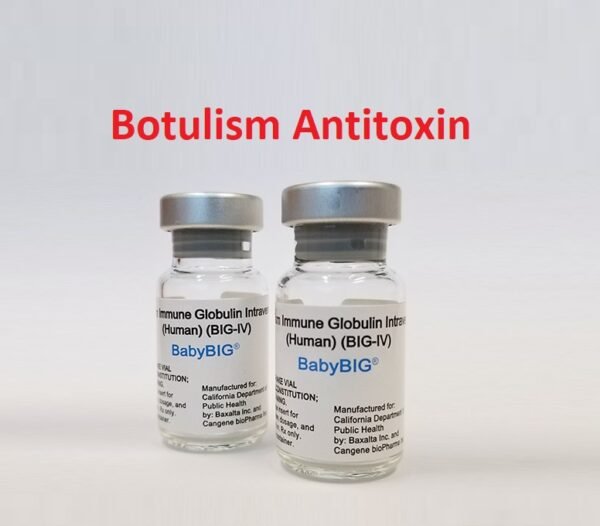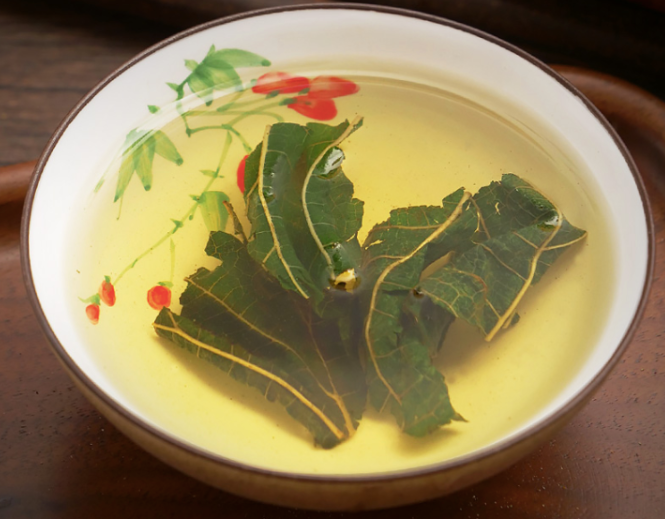Botulism Antitoxin contains immunoglobulin fragments that bind to botulinum toxins A, B, C, D, E, F, G. It is used in children and adults with documented botulism.
Equine serum heptavalent botulism antitoxin Uses:
-
Botulism:
- Quine serum heptavalent botulism antitoxin is used in the management of symptomatic botulism in adult and pediatric age group patients following confirmed and suspected exposure to botulinum neurotoxin serotypes A to G.
Botulism Antitoxin Dose in adults
Botulism Antitoxin Dose in Adults:
-
Treatment:
- IV: One vial; Note: A single vial contains about 10 to 22 mL of the serum depending upon different manufacturers.
Botulism Antitoxin Dose in in Childrens
Note:
- Before administering the antitoxin caution should be exercised for hypersensitivity reactions and skin sensitivity tests should be performed.
- The volume of the vial variates from 10-22 mL.
- In pediatric patients, the dose should be calculated according to volume in the vial.
Botulism Antitoxin Dose in Skin sensitivity test:
-
Infants, Children, and Adolescents:
- It can be given as Intradermal injection:
- 0.02 mL of 1:1000 dilution in NS given intradermally on the volar surface of the forearm.
- It is interpreted as, if the test is negative, the dose should be repeated using 1:100 dilution.
- Concomitantly positive test also known as histamine test and negative (saline) control tests.
- A positive reaction is interpreted as a wheal with surrounding erythema greater than 3mm larger than the negative control test and the test is rea after 15 minutes.
- The histamine control test should be positive for a proper conclusion. A negative test does not eliminate the chance of an abrupt or delayed reaction.
- It can be given as Intradermal injection:
Botulism Antitoxin Dose in the treatment of Botulism:
-
Infants <1 year:
- IV: 10% of the adult dose (one vial), bodyweight adjustment not required
-
Children ≥1 year and Adolescents <17 years:
- IV: 20% to 100% of the adult dose according to body weight. The minimum dose is 20% of one vial. The maximum dose can be given up to one vial.
-
The percentage of the adult dose to be administered is based on patient weight according to the following Salisbury Rule equations:
- ≤30 kg: Percentage (%) of Adult Dose to be Administered = Weight (kg) x 2
- >30 kg: Percentage (%) of Adult Dose to be Administered = Weight (kg) + 30
-
The following doses are recommended using the above equations:
- 10 to 14 kg: 20% of one vial
- 15 to 19 kg: 30% of one vial
- 20 to 24 kg: 40% of one vial
- 25 to 29 kg: 50% of one vial
- 30 to 34 kg: 60% of one vial
- 35 to 39 kg: 65% of one vial
- 40 to 44 kg: 70% of one vial
- 45 to 49 kg: 75% of one vial
- 50 to 54 kg: 80% of one vial
- ≥55 kg: One vial
-
Adolescents ≥17 years:
- One vial
Botulism Antitoxin Pregnancy Risk Category: C
- There have not been any studies on animal production.
- We have limited information, but it appears that the use of older equine products (BAT-AB, and BAT-E) is not indicative of any need to treat pregnant patients differently from standard practice.
- Antidotes used in pregnancy should be considered in all cases. Females should receive the antidote if necessary, regardless of any risk of teratogenicity.
Equine serum heptavalent botulism antitoxin use during breastfeeding:
- It is unknown if breast milk contains botulism antitoxin.
- Consider this: The physician should consider serious adverse effects of the antitoxin.
- If clinically necessary, they should withhold them but not at risk to the mother's health.
Dose in Kidney disease:
There is no dosage adjustment requirement given in the manufacturer's labeling.
Dose in Liver disease:
There are no dosage adjustments mentioned in the manufacturer's labeling.
Side Effects of Equine serum heptavalent botulism antitoxin:
-
Cardiovascular:
- Edema
-
Central nervous system:
- Chills
- Headache
-
Dermatologic:
- Skin rash
- Urticaria
- Pruritus
-
Gastrointestinal:
- Sore throat
- Nausea
-
Miscellaneous:
- Fever
Contraindications to Equine serum heptavalent botulism antitoxin:
The manufacturer's labeling does not list any contraindications.
Warnings and precautions
-
Allergy delayed:
- A delayed allergic reaction or severe serum sickness may occur between 10 and 21 days following the administration of antitoxin.
- Every patient needs to be kept an eye on for delayed allergic reactions. Give adequate medical attention as required.
-
Hypersensitivity
- Anaphylaxis or anaphylactoid reactions may cause severe hypersensitivity reactions.
- The most vulnerable patients are those who have a history of hypersensitivity to horses, equine blood products, or asthma.
- It is advisable to begin therapy with the smallest infusion rate feasible (0.01 mL/minute).
- Monitor all patients for severe allergic reactions, including those who have received antitoxin infusions.
- If a patient develops a hypersensitivity reaction, discontinue administration of the antitoxin.
- There should be access to immediate care, including epinephrine 1 mg/mL.
-
Infusion reactions
- Infusion reactions (eg: arthralgia and chills, fatigue. nausea, vasovagal reactions. vomiting) can occur.
- If you notice that you are experiencing an infusion reaction in a patient, reduce the rate of infusion and treat the symptoms. If the symptoms persist, stop infusions.
Monitoring parameters:
- Vital signs should be monitored and caution should be taken for infusion-related drug reactions.
- Acute hypersensitivity reactions can also be demonstrated.
- Physicians should keep in mind for delayed hypersensitivity reactions up to 10 to 21 days.
How to administer Equine serum heptavalent botulism antitoxin?
IV:
- Use a continuous infusion pump and an IV line.
- The first 30 minutes of treatment should be spent with a decreased infusion rate; if tolerated, the rate may be increased every 30 minutes until the maximum infusion rate is used for the remaining 30 minutes of the infusion.
- Keep an eye on your vitals while getting the infusion.
Initiate and increase the infusion rate as follows:
- Initial: 0.5 mL/minutes;
- Every 30 minutes, the infusion rate may double up to a maximum of 2 mL/minute.
Mechanism of action of Equine serum heptavalent botulism Antitoxin:
- It has antibodies that bind to and neutralise the free botulinum nerve toxin A, B, C, and D, E, F, and G. These antibodies are specific for the botulinum neurotoxin F(ab')2 and similar F(ab')2 antibodies.
- The neurotoxins are therefore prevented from interfacing with the cholinergic nerve ends and endocytosing into target cell cells.
- This reduces nerve damage and severity. Botulism antitoxin cannot reverse toxic pre-existing manifestations, so it is important for clinicians to be aware of this fact.
Half-life elimination:
- Antitoxin serotype A: 8.6 hours
- Antitoxin serotype B: 34.2 hours
- Antitoxin serotype C: 29.6 hours
- Antitoxin serotype D: 7.5 hours
- Antitoxin serotype E: 7.8 hours
- Antitoxin serotype F: 14.1 hours
- Antitoxin serotype G: 11.7 hours
Botulism Antitoxin Brand Names International:
Availability is limited to CDC distribution from the strategic national stockpile in consultation with the local health department.
Equine serum heptavalent botulism antitoxin Brand Names in Pakistan:
No Brands Available in Pakistan.


 Injection for familial chylomicronemia syndrome.jpeg)

